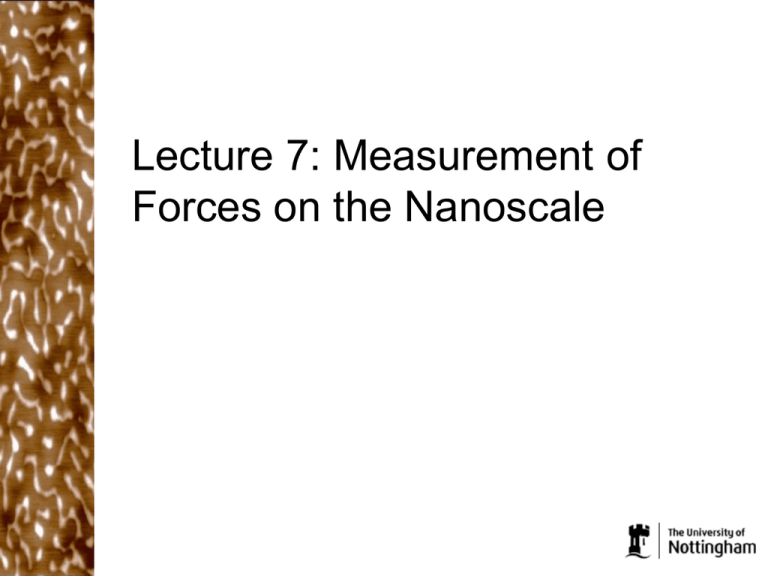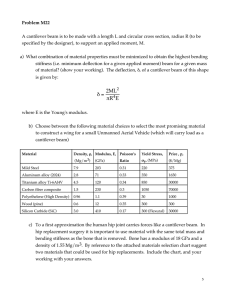JSS7
advertisement

Lecture 7: Measurement of Forces on the Nanoscale What did we cover in the last lecture? Interactions between macroscopic bodies.The effects of geometry on dispersion interactions Determining the energy scale of dispersion interactions (Hamaker constant, A~ 10-20 J) Range of interactions between macroscopic bodies can be up to 100nm Magnitude of forces between macroscopic bodies (pN to nN ) In this lecture… How do we measure nanoscale forces? Atomic Force Microscopy Cantilever deflection method Detection technique Useful references Intermolecular and surface forces, J Israelachvili (Academic Press) The Feynman Lectures on Physics, Feynman, Leighton and Sands (Addison Wesley) Scanning Force Microscopy, D. Sarid (Oxford Series in optical and imaging sciences) Scanning Probe Microscopy and Spectroscopy: Methods and applications R. Wiesendanger (Cambridge University Press) Forces at the nanoscale Forces between nanoscale objects typically occur in the range 1pN-1nN and can be difficult to measure. Ideally we need a measurement system where the change in applied force gives a linear response in the measurement device (although this is not necessary) Recall z -Fspring Fspring kz Atomic force microscopy In the first year, you considered how atomic force microscopy can be used to image the surface of a sample 20mm x20mm Contact mode Non-contact (tapping) mode AFM can also be used to measure forces… The AFM cantilever bends/deflects in response to an applied force l The force, F, on the cantilever is z F kz F where 3EI k 3 l E= Youngs Modulus of cantilever (Pa) I= Geometric moment of inertia (m4) (See OHP) Problem I Calculate the spring constant of a 200 mm long, 10 mm wide and 1 mm thick AFM cantilever having a rectangular cross section and a Young’s modulus of E=150 GPa. Hence determine the displacement of the cantilever when a force of a) 1picoNewton b) 1nanoNewton is applied to it. How do we detect the deflection of the cantilever? The deflection is detected by reflecting a laser beam off the back of the cantilever. Laser light (633nm) The light is collected on a split photodiode detector Photodiode current Interpreting the photodiode signal The photodiodes are connected to a differential current amplifier which produces a signal that is proportional to the difference in photocurrents generated by the two diodes isignal i1 i2 If isignal > 0 force acts upwards If isignal < 0 force acts downwards Can measure 0.1nm cantilever displacements Calibrating the cantilever spring constant I: hang weights off the end In practice, it is often difficult to calculate the spring constant of a cantilever, so it has to be measured! One way to do this is to place objects of known mass on the cantilever and measure the deflection z (or current signal isignal) However, this is tricky and can result in contamination of the cantilevers! Calibrating the cantilever spring constant II: Thermal tuning A more elegant method involves measuring the natural response of the cantilever in response to thermal motion z The mean square displacement of the cantilever <z2> is obtained from the noise signal and used in combination with equi-partition theory (more on this in Thermal Physics ) to give; k BT k 2 z How small a force can we detect? Typical cantilever spring constant: 0.01-50 Nm-1 We can routinely measure cantilever displacements of ~ 0.1nm We can therefore measure forces > 10 pN with relative ease using AFM Example 1: Force-distance curves AFM can be used to map out the dispersion (and other) forces as a function of the distance between sample and tip Surface http://www.nanoscience.com/ Example II:Protein (un-)folding AFM is routinely used to map out the forces associated with the folding and unfolding of individual protein molecules blenderartists.org/forum/s howthread.php?t=109254 G. Bao & S. Suresh Nature Materials 2, 715 - 725 (2003) Summary of key concepts Atomic force microscopes can be used to measure forces F The spring constant of an AFM cantilever is determined by its material properties and its physical dimensions A split photodiode arrangement is used to detect deflections and to measure forces with >10pN precision F kz 3EI k 3 l




